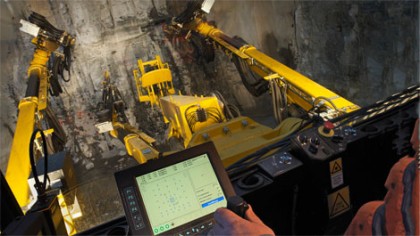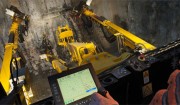RCS – The control system with unlimited potential
As the innovator and pioneer of the first computerized control system for heavy industrial equipment, Atlas Copco now leads the world in the drive for total integration and optimization in mining and construction operations. At the heart of this effort is Atlas Copco’s unique Rig Control System (RCS) which has the potential to radically change today’s working methods.
Old habits die hard, as the saying goes, and this is certainly true of the mining and construction industry. Whenever new ideas come along, some people are more reluctant than others to give up traditional working methods. Others are prepared to venture into new territory but on a limited scale, while a few see the full benefits immediately and try to ?get on board? as soon as the opportunity arises.
This is understandable in a world where the first priority is the present, and where ongoing operations leave little time to step back, take stock and consider the wider picture.
Seen from this standpoint, Atlas Copco?s Rig Control System (RCS) is probably the most interesting technical development since computerization was first introduced into heavy equipment. Not because of the abundance of features and functions that RCS provides ? although considerable ? but because of what it can mean for the future development of mining and construction procedures and for the lives of the many thousands of professionals who carry them out every day.
In this sense, rather than Rig Control System, RCS could just as well stand for ?Radical Change System? as it is the system that enables man and machines to organize, integrate, co-ordinate and optimize in ways that can lead to unprecedented efficiency and productivity.
Back to the future
To fully understand the potential offered by the RCS innovation, it is necessary to take a brief look at how it all started. The inspiration came from the automotive industry in the late 1980s. The system being used in vehicles at that time, widely referred to as CANBUS, consisted of a great many sensors and cables that controlled a large number of functions such as raising and lowering electric windows, automatic adjustment of mirrors, brakes, and so on.
The Atlas Copco engineers wanted to adapt it to the functions of a drill rig, but were also convinced that the amount of cable-s required (about 200 in the average car) would have to be drastically reduced for reasons of weight, and that the whole system would have to be substantially simplified.
The answer they came up with was simplicity itself: one main cable (containing four wires), one main computer, a number of secondary PCs strategically placed around the drill rig and groups of sensors.
The central computer could be programmed to ?talk? with the secondary PCs, make sophisticated decisions and issue specific commands. Each secondary PC would be responsible for controlling just one major function or component ? a boom for instance. These would carry out the central PC?s commands and, with the aid of the sensors, continuously gather and log performance data and feed this information back to the central PC for storage and analysis.
The result was a system that enabled the operator to exercise full control over all of the drilling functions using the onboard computer screen and control panel, providing a much higher level of precision and paving the way for automation.
Full scale development got under way in 1990 and evolved over the next eight years, finally culminating in the launch of the first underground rig, a Boomer L2 C, equipped with the first generation RCS.
Technically it was a triumph but, as suspected, it was not an immediate success. Drillers were sceptical towards computerization and automation, with many -dismissing it as inferior to the skill of an experienced driller. To some extent, they were absolutely right. The system was not a substitute, but used correctly it was a fantastic complement.
Convinced that the future lay in automated systems, Atlas Copco pressed on with RCS technology and over the next 10 to 12 years the company released a constant stream of RCS-based products. And with each new release, the system had also been upgraded in line with the evolution of computer hardware, software and connectivity.
The second generation RCS platform for Boomer rigs was launched in 2000?2001 and 2002?2006 saw the launch of the third generation RCS-based equipment including loader-s, exploration rigs and Robbins raiseborers in rapid succession.
The fourth generation RCS platform was introduced in 2007?2010 with the launch of the Diamec diamond core drill rig and the Pit Viper 271 rotary blasthole rig.
Today, the entire portfolio of Atlas Copco equipment for mining and construction is available with the same RCS platform and Atlas Copco is now working on what will be the fifth generation.
All about communication
M&C asked Mikael Ramström, Product Line Manager Underground Drilling Equipment and a member of the RCS team during most of this development period, to put the project into perspective.
?The key driver in this effort was not just to improve the way a drill rig could be controlled but to establish routines for how the different units could communicate more effectively-,? he says.
?It was important to us that the mine office and the drill rig operator could share information, that the same information could be made available to others involved in the process, that procedures and performance data could be logged and analyzed and so on…all in the name of increasing precision and productivity.?
PCMCIA cards
In this respect, the introduction of drill rig PCMCIA cards was a milestone. These could be programmed in the mine office, with drill plans for example, and then simply slotted into the rig?s RCS system. Drilling in the automatic mode, the system would then simply follow the instructions and the booms would be automatically guided to exactly the right spot.
PCMCIA cards have now been replaced and communication from mine office to rig is now via USB or WLANs (Wireless Local Area Networks) which allow drill plans that are drawn up in the office to be directly transmitted to a rig anywhere in the mine and the drilling parameters instantly displayed on the rig?s screen.
With its visionary approach and many years of experience in developing the RCS platform, it is not surprising to discover that Atlas Copco leads the field in this technology with more than 1 800 RCS machines in operation around the world.
Among the companies that are today reaping the benefits of RCS technology are Veidekke, Marti Tunnelbau and Bergteamet, all featured in this magazine, as well as Boliden, NCC, ILFS and numerous others.
A contributing factor to this growing trend is that the equipment is accompanied by extensive training programs where Atlas Copco is able to offer operator training using advanced drill rig simulators. So far, these are available for Boomer, ROC and Pit Viper rigs as well as Scooptram loaders. The result is a wider acceptance of computerized drilling around the world and increased confidence in Atlas Copco as the global expert.
A shift to information
If computerized drilling is now on track to become the norm, what will be the next chapter in the evolution of RCS?
Mikael Ramström explains that although development of the fifth generation RCS project is under way, the focus has now shifted.
?The development of RCS has been conducted in three phases. Firstly we concentrated on control, secondly, we focused on communication but now it is all about information,? he says.
?Today, our efforts are concentrated on identifying which information should be made available to all of the machines involved in a given operation.
?RCS is an incredible tool. If it is exploited to the full it can be used to fine-tune and optimize an entire operation in ways that have never before been possible. And the beauty of it is, despite what some people think, it is not at all complicated. It?s really very simple.?
Atlas Copco?s RCS technology is designed with the long-term future of the mining and construction industry in mind. But with more and more companies now opting for RCS-based equipment, the full potential of this technology to revolutionize the way things are done may not be that far off.
Epiroc operated under the trademark “Atlas Copco” prior to January 1, 2018.



Here:
Us: